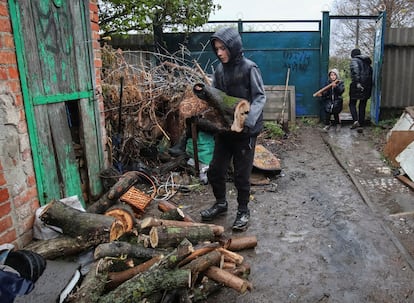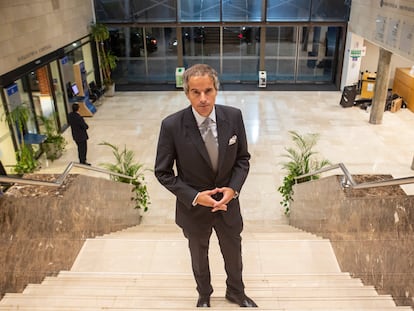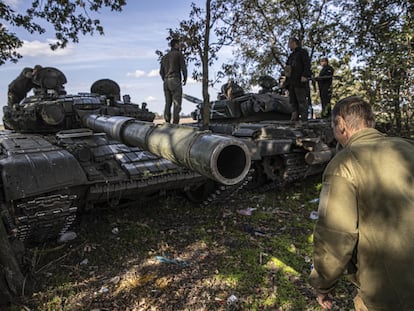Ukrainians prepare for harshest winter in decades
Russian strikes against the country’s energy grid could leave millions without power, water and heating to protect against freezing temperatures

Ukraine is already experiencing freezing nighttime temperatures, and hundreds of thousands of people are being forced to endure then without any source of heating. That is because on October 10, Moscow began massive attacks against the Ukrainian power grid; since then, not a day has gone by without a strike against infrastructure that is key for the survival of the population. This past Saturday was the most devastating day yet, according to a statement issued by Ukrenergo, the state company that manages the national electricity grid: more than 30 Russian missiles left entire populations in 10 provinces without electricity. In Lutsk, a western city near Poland, the hot water supply was interrupted. The Ukrainian president, Volodímir Zelenskiy, and the president of the European Commission, Ursula von der Leyen, have both described this strategy as a war crime.
The war will bring Ukraine the harshest winter in decades. Yurii Vitrenko, president of the state gas company Naftogaz, said as much in August, and since then the situation has only gotten worse. In October, Russia has been focusing on destroying Ukraine’s energy infrastructure. More than 40% of the country’s electricity network is out of service, in addition to hundreds of kilometers of gas pipes, water pipes and all the refineries. Russia’s goal is to leave millions of people without resources to cope with the cold.
Vitrenko warned in an August interview with The Guardian that they were planning to reduce indoor temperatures by an average of four degrees this winter – heating in Ukraine is centralized and controlled by local authorities. Two months later, on October 14, the president of the gas company confirmed in an interview with The Kyiv Independent that the situation was worse than expected because many of its water heating plants had been rendered useless. Vitrenko also warned that Ukraine had less than half of the gas reserves needed to spend the winter safely: the gas that it imported from the European Union has stopped flowing because its European allies have to face their own energy crisis.
In Kyiv, the heating season should have started two weeks ago, but Naftogaz has confirmed that this year it will start later and end earlier due to the lack of gas and coal. The two main coal mines in Ukraine have suspended their activity due to the attacks. The alternative for millions of people are electric stoves, but this resource is also at risk, as President Zelenskiy made clear this week: a general blackout is possible. The Ministry of Energy figures it has lost 50% of thermal generation – coal and combined cycle plants are the main source of electricity in the country – in addition to 30% of solar plants and 90% of wind farms. And there’s more: the Zaporizhzhia nuclear power plant, which provided 20% of Ukraine’s electricity production, is now in the hands of Russian forces.
Less transportation and lighting
Municipalities are already reducing the electricity consumption of their buildings, public transportation and urban lighting, and in some cases, such as the city of Zhytomyr, power cuts are taking place at certain times on certain days of the week. Millions of citizens are voluntarily reducing consumption, as can be seen in Kyiv, where many businesses have turned off part of their lighting. Yet this, according to the Ministry of Energy, will not be enough to prevent power outages from becoming a regular occurrence.
Authorities are reiterating that citizens must stock up on equipment to combat the cold, from sleeping bags and thermal clothing to diesel generators in residential buildings. The Minister of Territorial Policy, Oleksii Chernisov, made an appeal on October 12 at a conference of the US think tank Atlantic Council, asking international allies to send generators, fuel, mobile water purification plants and mobile boilers. “Winter is going to be very hard, we were not prepared, we did not foresee an attack on this scale against the energy network,” former Deputy Foreign Minister Olena Zerkal said at the same conference. “This winter will be very, very dark and cold,” added Oksana Nechiporenko, director of the NGO Global Office.

Dozens of people were lining up in Kyiv on Saturday in front of the headquarters of a non-profit group where volunteers distributed boxes of food to refugees from Mariupol, the city on the coast of the Sea of Azov devastated by the Russian siege last spring. Officials at the non-profit said they are getting requests for help to get through the winter. People are asking above all for clothes and sleeping bags. Ukraine has about seven million internally displaced people, according to a United Nations count – people who have fled with little more than the clothes on their back from areas close to the fighting.
Former Deputy Minister Zerkal anticipates that the situation will cause a new wave of migration to the European Union, but also to other areas of Ukraine with more resources, especially families with children. EL PAÍS has interviewed several people in Kyiv in the last week who confirmed that they are getting ready to leave the capital to settle in second homes or in relatives’ houses in rural areas with autonomous heating and access to drinking water. Yulia Makuha was at a mountain equipment store in Kyiv last Saturday to buy thermal clothing and a sleeping bag for the low temperatures of the Ukrainian winter, which can drop to -10ºC (14ºF). Makuha explained that she was planning to move to the province of Vinnitsa, in the center of the country, where her parents live in a house that has its own heating system that can work with either coal or wood.
“The number of people who are coming to the store has skyrocketed,” said Sergei Dogov, manager of the Kaprikorn mountain equipment store in Kyiv. “Above all they are buying gas stoves, warm clothing and sleeping bags,” Dogov said. These are the same products that the city’s mayor, Vitali Klitschko, recommended purchasing two weeks ago for the coming months. The store manager said he has equipped his own apartment with folding solar panels to place on the balcony, along with sleeping bags a a stove and several gas canisters.
In Horodnia, a rural area 200km (124 miles) north of Kyiv, daytime temperatures are already close to freezing. In the center of town, a clothing distribution point has been set up for evacuees from the eastern provinces, those closest to the front. Last Wednesday Galina Volechuk, head of the distribution center, and her team of retired volunteers commented on the situation with resignation. “Russia will not win this battle, we know how to live with the cold,” she noted.
Prominent Kremlin propagandists have been putting out the message on social media that the cold will now be a weapon for Russia, as it was for the Soviet Union when it stopped the German invasion in World War II. But the differences are evident: on this occasion, the invader is Russia, and it is dealing with a country that also knows how to live with the cold.
Tu suscripción se está usando en otro dispositivo
¿Quieres añadir otro usuario a tu suscripción?
Si continúas leyendo en este dispositivo, no se podrá leer en el otro.
FlechaTu suscripción se está usando en otro dispositivo y solo puedes acceder a EL PAÍS desde un dispositivo a la vez.
Si quieres compartir tu cuenta, cambia tu suscripción a la modalidad Premium, así podrás añadir otro usuario. Cada uno accederá con su propia cuenta de email, lo que os permitirá personalizar vuestra experiencia en EL PAÍS.
¿Tienes una suscripción de empresa? Accede aquí para contratar más cuentas.
En el caso de no saber quién está usando tu cuenta, te recomendamos cambiar tu contraseña aquí.
Si decides continuar compartiendo tu cuenta, este mensaje se mostrará en tu dispositivo y en el de la otra persona que está usando tu cuenta de forma indefinida, afectando a tu experiencia de lectura. Puedes consultar aquí los términos y condiciones de la suscripción digital.
More information
Archived In
Últimas noticias
A survivor’s account of the Interoceanic Train accident: ‘We were scared because of the speed on the curve’
The Interoceanic Train, the Mexican alternative to the Panama Canal
What is known about the Interoceanic Train derailment in Oaxaca
Trump turns a Minnesota fraud allegation into ammunition for his MAGA army against Democrats
Most viewed
- Oona Chaplin: ‘I told James Cameron that I was living in a treehouse and starting a permaculture project with a friend’
- Reinhard Genzel, Nobel laureate in physics: ‘One-minute videos will never give you the truth’
- Why the price of coffee has skyrocketed: from Brazilian plantations to specialty coffee houses
- Pablo Escobar’s hippos: A serious environmental problem, 40 years on
- Chevy Chase, the beloved comedian who was a monster off camera: ‘Not everyone hated him, just the people who’ve worked with him’










































